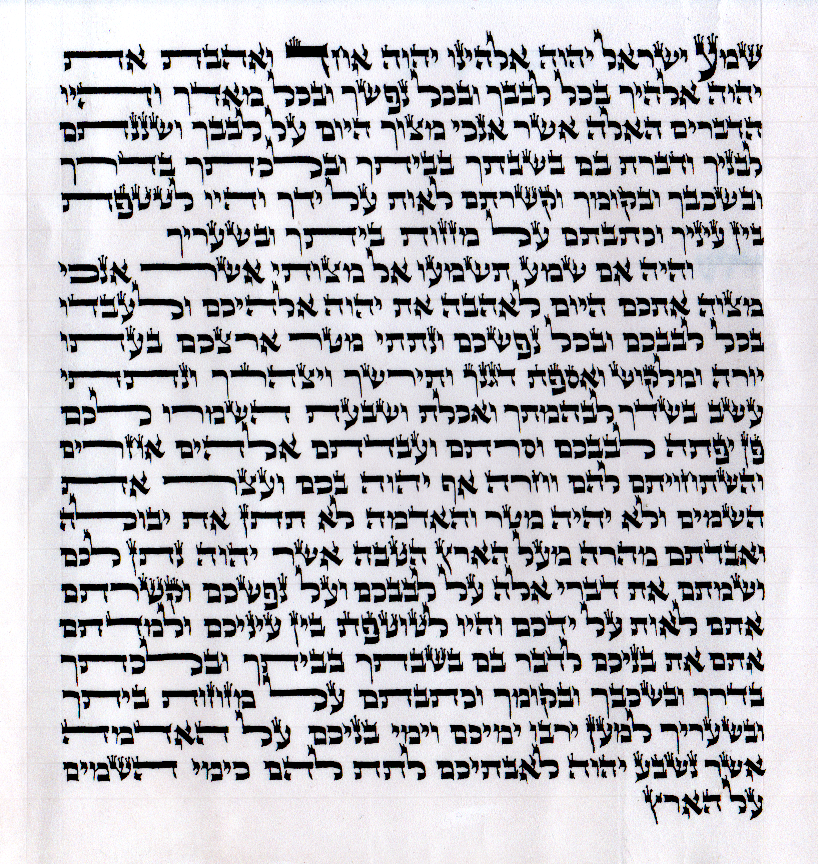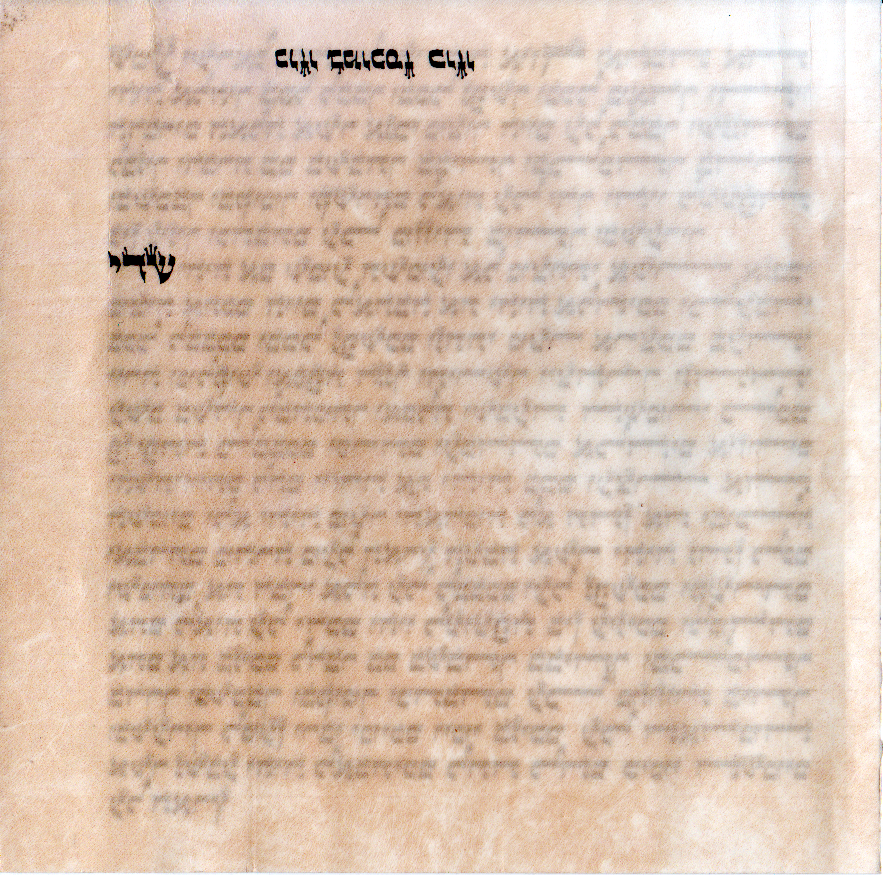- Home
- Activities
- Letters
- Diary
- Tools
- Books
- Education
- Sources
- Oddities
-
MORE
- About me
- Sefer Torah
- Tefillin
- Pittum HaKtoret
- Ketubah
- Alefbet
- Diary 1
- Diary 2
- Diary 3
- Diary 3a
- Diary 4
- Diary 5
- Diary 6
- Diary 7
- Diary 8
- Repairs
- More Repairs
- Yet More Repairs
- Diary 45
- Diary 39
- Broken Vav
- Joined Kuf
- Diary 11
- Diary 46
- Diary 47
- Siyyum
- Some siyyumim
- Diary 26
- Diary 27
- Raised vav
- Kulmus
- Giddin
- Purim shpiels
- Diary 40
- Diary 42
- Kulmus Books
- Mezuzah
- Large letters
- Diary 48
- Diary 49
- Diary 18
- Sefer Binsoa
- Dyo
- Klaf
- In the End
- Adventures in Practical Halachah
- Sefer Tagin Fragments from the Cairo Genizah
- Diary 50
- Megillat Esther
- My first megillah
- 2018 Megillah
- The E-Fuzzy
- Ketubah 2 Avielah's Gallery
- Publications and audio visual
- Old Harrys Ketubah
- Commemorative illuminations
- Diary 51
- Diary 52
Mezuzah
All about the mezuzah
The mezuzah
is affixed to the doorposts of the Jewish house, most every door (except bathrooms or very small rooms that people do not regularly use).
Two passages of Torah
are written in the mezuzah: 'Shema'
[Deut. 6: 4-9] and 'Vehaya im shamo'a'
[Deut 11:13-21]. They are written in in one column on one sheet. They are included as they are the two sections that make reference to the specific commandment of mezuzah, 'and you shall write them on the doorposts of your home and your gates'. Originally the word mezuzah
referred to the doorpost itself not the parchment and indeed mezuzot
parchments could also be stored in hollowed out parts of the doorpost (wood or stone) not affixed in a container. The writing must be done in kosher
black ink and must be on lines ruled with a sargel. Even though the scroll is hidden from view it must be beautiful writing and straight. (Tefillin
are exempt from ruled lines other than the top one - though no sofer
would do it without). It must be written in k'tav ashurit
(Assyrian script) - nothing else is permitted.
Below: the inside of one of my mezuzot (15cms square). Image © Mordechai Pinchas.
According to Sofrim
9:4 originally all the letters in Shema Yisrael
(Hear O Israel) were enlarged, not just the ayin. Sforno explains that the ayin
is enlarged as it means the word means eye with which we perceive/witness God's Oneness.
The dalet of the word 'echad' is made larger than the other letters. Indeed the the ruling is that it must be 4 times the size of a normal dalet (though usually this is not the case as mezuzot are generally small). It is large to ensure that the word is not read as 'acher' meaning (heaven forbid) [God is] 'another'. In addition the custom is also to enlarge the letter ayin so that both letters together read as 'ed' (witness) to complement the aural idea of shema (hear).
The gap that is between the section 'Shema' and the section 'V'hayah im shamo'a' is a setumah (a closed section) and we are accustomed to begin line 7 with 'v'hayah im shamo'a. One should write a mezuzah in one column but if one wrote it in two or in three columns it is nonetheless valid. However if one wrote it on two skins even if they were sewn together it is invalid.
One writes all its lines equal in length so that they are justified on both sides. To achieve this may involve the stretching of certain letters, though only some are allowed to be stretched, and even then they mustn't be so extended that the become unrecognisable. Stretchable letters include: dalet, heh, lamed, resh and tav, and, in exceptional circumstances, aleph, kaf and final mem. If one lengthened or shortened one line more than the one before it or the one underneath it is still kasher (valid). However only if this is accidental for if a pattern emerges e.g. a triangle or curve then it is pasul (invalid).
We are accustomed to make a mezuzah 22 lines long. One should write the last two words al ha'arets (on the earth) at the start of the last line and not write any more after it.
On the reverse of the mezuzah behind the Hashem Elokeynu Hashem of the first line is the text ‘kuzo b’mochsez kuzo’ written upside down. These are the next letters on in the Hebrew alphabet and have some kabbalistic symbolism, perhaps to do with God in motion, i.e. a continuous presence. Maimonides felt very strongly that this custom should not be pursued. Also on the reverse of the space before the second paragraph ‘Vehayah im shamo’a’ is the word Shaddai - meaning Almighty. The letters have come to stand for ‘Shomer D’latot Yisrael’ (Guardian of the doors of Israel) but this is unlikely to be its real origin.
The Shaddai should be seen through a transparent section in the mezuzah casing, the bayit, but since most mezuzot do not do this, the letter shin is often part of the outer casing design. Sadly people do tend to put a lot more thought into the casing, than the actual document inside when that is in fact the most important part.
The dalet of the word 'echad' is made larger than the other letters. Indeed the the ruling is that it must be 4 times the size of a normal dalet (though usually this is not the case as mezuzot are generally small). It is large to ensure that the word is not read as 'acher' meaning (heaven forbid) [God is] 'another'. In addition the custom is also to enlarge the letter ayin so that both letters together read as 'ed' (witness) to complement the aural idea of shema (hear).
The gap that is between the section 'Shema' and the section 'V'hayah im shamo'a' is a setumah (a closed section) and we are accustomed to begin line 7 with 'v'hayah im shamo'a. One should write a mezuzah in one column but if one wrote it in two or in three columns it is nonetheless valid. However if one wrote it on two skins even if they were sewn together it is invalid.
One writes all its lines equal in length so that they are justified on both sides. To achieve this may involve the stretching of certain letters, though only some are allowed to be stretched, and even then they mustn't be so extended that the become unrecognisable. Stretchable letters include: dalet, heh, lamed, resh and tav, and, in exceptional circumstances, aleph, kaf and final mem. If one lengthened or shortened one line more than the one before it or the one underneath it is still kasher (valid). However only if this is accidental for if a pattern emerges e.g. a triangle or curve then it is pasul (invalid).
We are accustomed to make a mezuzah 22 lines long. One should write the last two words al ha'arets (on the earth) at the start of the last line and not write any more after it.
On the reverse of the mezuzah behind the Hashem Elokeynu Hashem of the first line is the text ‘kuzo b’mochsez kuzo’ written upside down. These are the next letters on in the Hebrew alphabet and have some kabbalistic symbolism, perhaps to do with God in motion, i.e. a continuous presence. Maimonides felt very strongly that this custom should not be pursued. Also on the reverse of the space before the second paragraph ‘Vehayah im shamo’a’ is the word Shaddai - meaning Almighty. The letters have come to stand for ‘Shomer D’latot Yisrael’ (Guardian of the doors of Israel) but this is unlikely to be its real origin.
The Shaddai should be seen through a transparent section in the mezuzah casing, the bayit, but since most mezuzot do not do this, the letter shin is often part of the outer casing design. Sadly people do tend to put a lot more thought into the casing, than the actual document inside when that is in fact the most important part.
Below: the outside of one of my mezuzot (15cms square). Image © Mordechai Pinchas.
There are lots more laws regarding mezuzot. This is a very important mitsvah
incumbent upon every Jew.


